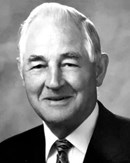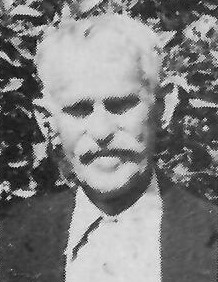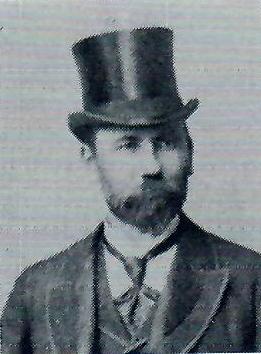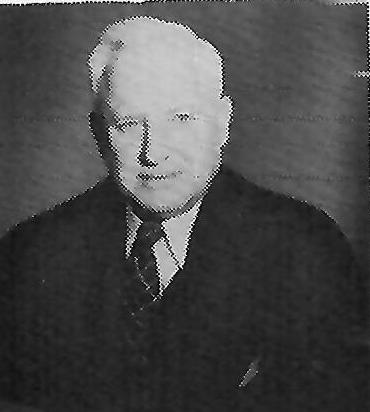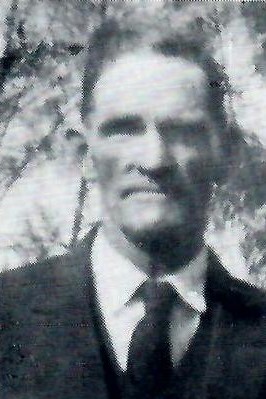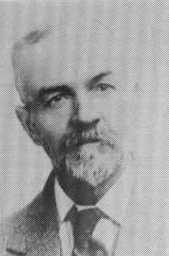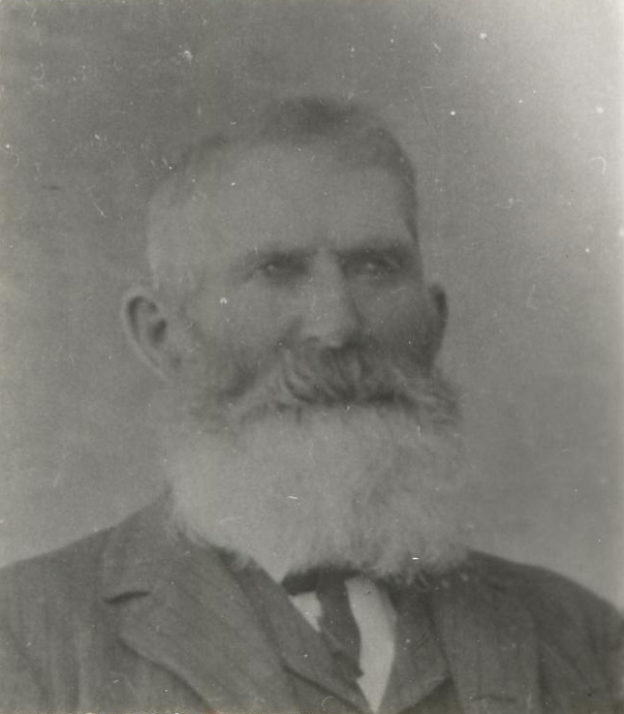Joseph Charles Bentley
1859-1942
Joseph Charles Bentley, son of Richard Bentley and Elizabeth Price, was born August 31, 1859 in Salt Lake City. He was the youngest child in a family of six. His parents were English converts who had emigrated to Utah in 1852.
The fall after Joseph’s birth, his father was called on a mission to England where he labored for four years. During his absence his wife struggled bravely to support her family, the oldest a girl of twelve. They lived in a little adobe house on North Temple Street.
Shortly after Richard Bentley’s return from England he was again called by President Brigham Young to take his family and move to St. George, in the extreme southwestern part of the territory of Utah. This move was a great trial to Elizabeth Bentley, but she was willing to go with her husband wherever the Church might call. Apostle Orson Pratt had been called home from St. George, so it was arranged that he and Richard Bentley would exchange homes.
Thus it was within the red sandstone hills of St. George, with the Virgin River flowing by, that Joseph grew to manhood. He began his meager schooling under Richard Horne. At the age of 15 he accepted a position of office boy for Robert C. Lund, who was the St. George operator of the Desert Telegraph. Young Joseph learned telegraphy and eventually took over the managership of the office. Later he was transferred to Silver Reef, a mining camp northeast of St. George, where he worked until he received his call for a mission.
At the age of 20, Joseph was called on a mission to England, where he labored as mission secretary in London. Upon his return home two years later he secured a position with the firm of Wooley, Lund and Judd, who operated a general store, Wells-Fargo Express Agency, and a telegraph office in St. George.
One day Sister Julia Jill Ivins asked Joseph if he would teacher daughter Margaret (or Maggie) telegraphy. An agreement was made to do this for the sum of $30 dollars a month. The young man found Maggie an apt student and a charming young lady, and he often walked her home after the lesson. That fall Maggie took a position as teacher Pine Valley, about 35 miles north of St. George. She frequently visited the telegraph office after school and was allowed to send messages to the young operator at St. George. This romance culminated the following summer in their marriage in the St. George Temple, June 30, 1886.
In 1892, Joseph Charles Bentley moved his wife and three small children to Mexico. The Mexican Mission had been founded by the Church some six years earlier, and the Chihuahua colonies were developing into thriving little communities. Settling the picturesque little town of Colonia Juarez, he purchased a quarter of a block near the center of town, on which were two small frame houses, some grapes, and a few fruit trees. In four of five years he constructed a fine, two-story home of red brick.
Joseph went into business with Anson B. Call and Dennison E. Harris. The firm of Call, Harris and Bentley engaged in cattle raising, farming and merchandising. He also started a co-op cannery for canning local fruits and vegetables. He was assisted in this plant by the Harris brothers, Franklin S. and J. Emer. Another co-op in which he was interested was the Juarez Tanning and Manufacturing Company, which engaged in the making of harnesses, saddles, and other leather goods.
In church affairs he was equally active. Soon after his arrival in Mexico he had been asked to assist Bishop George W. Sevey with his tithing records and was soon appointed Ward Clerk. In 1895, when the Juarez Stake was organized with Anthony W. Ivins as President, Joseph C. Bentley became the Stake Clerk. Then three years later he was made Bishop of the Colonia Juarez Ward, serving in that capacity some 18 years.
In the fall of 1894, Gladys Woodmansee, a cousin of Maggie Ivins Bentley, came down to the colonies on a visit. Years before, at the time of her marriage, Maggie had told her husband she believed in the principle of plural marriage and that if ever he decided to take another wife she would like it to be her cousin Gladys. As Joseph C. Bentley had long admired this young lady and she was agreeable to the union, the time seemed opportune. Accordingly to ceremony was performed by one of the Apostles who was visiting in the colonies at the time. As the Manifesto of 1890 applied only to the United States, there were no legal barriers to the marriage.
In 1897 Joseph Charles Bentley became a naturalized Mexican citizen, intending to make the land of his adoption his permanent home.
For years Bishop Joseph Charles Bentley had watched his interest the development of a certain red-haired lass, who was the daughter of one of his Counselors, Ernest L. Taylor. As the girl blossomed into young womanhood, Bishop Bentley, being a firm believer in the doctrine of plural marriage, sought her hand. At first she was rather unappreciative of his attentions, but after a rather persistent courtship he was successful. On September 23, 1901, Mary Maud Taylor, then but a girl of 16, became the third wife of Joseph C. Bentley.
Of course separate homes were maintained for each of the three wives. The family relationships of the Bentley’s were very harmonious. However, Bishop Bentley’s church duties took him away from home so much that the burden of raising and training the children fell largely upon the wives. On several occasions on or the other had the heart-rending experience of witnessing her child’s last breath and laying it out for burial while her husband was in Salt Lake City for conference or off on some missionary journey.
There were pleasant times, too. Each summer for many years Joseph Bentley made it a practice to take his families into the mountains for an outing, usually at North Creek above Chuhuichupa. In the midst of tall pines and with an abundance of fish and game, a good time was enjoyed by all.
Gladys had poor heath and died in March 1906. Her five children came to live with Maggie, and it was a very busy home for the next few years.
In 1910 Joseph C. Bentley organized a Board of Trade for the purpose of securing a better market for colony products. The colonies were producing fruit of unusual quality as well as canned goods and leather products. It was thought that by combing the produce of the various members it would be possible to ship in carload lots to more distant markets. An invitation was received from President Diaz to bring an exhibit to Mexico City. After arriving there Bishop Bentley was cordially received by the fair officials, allotted space for his exhibit, supplied with flags and bunting for decoration, and given the services of several men to unload and handle the produce. He then proceeded to erect a pyramid of colony cheeses as high as the ceiling, a huge stack of canned goods, and extensive displays of apples, peaches, flour, candy, saddles, and harnesses.
At the close of the exposition, a banquet was served to President Diaz and his cabinet, using colony produce. Afterward each minister was given a few samples to take home. The remaining produce was sold at a good price. This exposition opened up a thriving market for colony produce in Mexico City.
Before his return home, Bishop Bentley was granted a personal interview with President Porfirio Diaz, who state that he greatly admired the Mormon people because they set an example of a higher standard of living and morality which would benefit his people.
The decade of 1911-1920 was a troubled one in Mexican history. The 30-year dictatorship of President Porfirio Diaz, which had given Mexico peach and financial stability and encouraged foreign colonization and investment of foreign capital, was rough to an end by a popular revolt led by the crusading Francisco I. Madero, who in turn was succeeded by half a dozen other presidents in kaleidoscopic succession. The most colorful figure during this period was Francisco “Pancho” Villa, rebel, patriot, and bandit, but a man of his word and one who had great regard for the Mormon people.
Reported assurances were given to the Mormon colonists that their lives and property would be respected, and, owning to their neutral position, their firearms would be left in their possession. This promise was kept by both sides for about six months, but the Revolutionists, being short of arms and suffering one defeat after another, finally demanded the arms of the colonists.
On Saturday, July 26, 1912, the men of Colonia Juarez brought their guns and ammunition to the bandstand, where they were listed and counted by Bishop Bentley before turning them over to the rebel commander. Being left with no means of defending their families, the brethren placed their wives and children on the train and sent them out to El Paso, Texas. Numbered among the exiles were Maggie and Maud Bentley and their families.
Believing that his life was in danger from the rebel leader, Cavada, who had been making threats, President Junius Romney of the Juarez Stake fled into the mountains, leaving word for the rest of the brethren to join him there. It was sometime before theywere able to do this, however, as the rebels forbade anyone to leave town. Finally scouts came in with the news that a federal army was approaching, whereupon the rebels left. Although there was now apparently no further reason for leaving, Bishop Bentley said that in obedience to the Stake President he was going inot the mountains to join him and advised other the other brethren to do likewise.
On the following day a vote was taken and it was decided that the men of the colonies would proceed overland to the United States and join their families in El Paso. Before leaving, reliable Mexicans were placed in charge of their homes and property. The refugees were all mounted and had a couple of provision wagons and a considerable number of pack animals. Four days’ travel brought them to the border, and two more were required to reach El Paso.
On the very day of their arrival, the Stake Presidency, High Council, and Bishoprics met with Anthony W. Ivins to discuss their action in leaving their homes in Mexico and what future course they should take. There was heated discussion among the brethren as to the wisdom and necessity of the Exodus. President Romney stoutly defended his action and stated that he would never return to Mexico unless called to do so by the General Authorities. Bishop Joseph Charles Bentley said that in his opinion there had been no need either for their families or the men to leave and that as far as he and his families were concerned they had left solely in obedience to the counsel of the Stake President.
After a series of meetings, it was decided that all Stake and Ward authorities who did not desire to return to the Mexican colonies would be honorably released, and more than 500 free railroad passes were given to refugees who desired transportation to other parts of the United States. Within about two weeks after the Exodus, some 60 men, including Bishop Joseph C. Bentley, Ernest and Alonzo Taylor, John W. Wilson, Daniel Skousen, and John Hatch, were ready to return to their homes in Colonia Juarez. Upon reaching there, Bishop Bentley found everything just as he had left it, his faithful hired man, Cornelio Reyes, having remained true to his trust. As conditions remained quiet for several weeks, a number of families returned to Colonia Juarez. Among them were those of Maggie and Maud Bentley.
The colonists were not molested for more than a year. Then in April 1914 came the startling news that American troops had stormed and captured Veracruz. Feelings ran high on both sides of the border and it appeared that war between the United States and Mexico was imminent.
Some irresponsible parties sent an exaggerated report to President Joseph F. Smith in Salt Lake City, telling him that all the Mormon colonists in Mexico were in grave danger. Acting on this advice, President Smith promptly called the settlers out; however, by September the war scare had subsided, and the Bentley families returned to their homes, where they remained during the balance of the Revolutionary period.
As Bishop Bentley was the only presiding officer of the Juarez Stake to return to the colonies, he was directed by the General Authorities at Salt Lake City to take over and close the tithing records of the various Wards which had been disorganized and to exercise general supervision over all the Saints who had returned to Mexico. In 1915 he went to Salt Lake City to attend April Conference. On April 10, after sessions had concluded, he called at the office of the First Presidency. President Josph F. Smith and his two Counselors, Anthon H. Lund and Charles W. Penrose, placed their hands on his head while President Lund pronounced a blessing. Then President Smith proposed that they set Bishop Joseph Charles Bentley apart as President of the Juarez Stake. President Penrose acted as mouth.
Upon returning to Mexico, Bishop Bentley had the unusual distinction of serving both as Bishop and as Sake President for a little over a year until Apostle Ivins came down in May 1916 and released him from the Bishopric, at the same time setting apart John T. Whetten and Arwell L. Pierce as Counselors to assist him in the Stake Presidency.
Taking the lead in community as well as church affairs, President Bentley made two trips to Mexico City to obtain government confirmation of the land titles of the colonist. He also continued to operate a general store in Colonia Juarez, for a time in partnership with John W. and Guy C. Wilson and, after the Exodus, alone. However, the store was looted so many times by rebel bands that the venture was finally abandoned.
One day during the Revolution, Bishop Joseph Charles Bentley and several others paid a visit to General Villa, who was camped at Casas Grandes. They requested a written order which would protect their work horses from seizure by rebel foragers. Villa obligingly wrote out the order and gave copies to Bishop Bentley and Bishop Anson B. Call of Colonia Dublan. Villa then remarked that his men were badly in need of bedding and he would like to buy some. Bishop Bentley replied that his store in Colonia Juarez was only a grocery, but that he would see what he could do. After returning to Colonia Juarez, Bishop Joesph C. Bentley gathered up a collection of surplus bedding from the townspeople and presented it to Villa as a gift.
During General Pershing’s campaign in Mexico (March 1916 – February 1917) he made his headquarters in Colonia Dublan and was very friendly toward the Mormon colonists. After receiving orders to abandon the search for Villa, Pershing tried to persuade President Bentley to leave Mexico with the army and even offered the use of his own private car. However, President Bentley felt that the colonists were in no danger and there was no reason to leave the country.
In March, 1919, President Joseph Charles Bentley, in company with Burt Whetten and Albert Tietjen, set out to visit some of the missionaries who were laboring in the villages to the south. They were traveling in a light buggy drawn by a team of mules. Between El Valle and Namiquipa they encountered some of Villa’s men and were taken into custody. They were transferred from place to place and held prisoner for three days before they finally gained an audience with Villa. In talking with the general, they learned that he had once lived with a Mormon family in Sonora and knew considerable about the Mormon people.
Villa said, “Many times I might have entirely cleaned up on all of you Mormons and destroyed the colonies, but I have never had any desire at all to do you any harm. I would like to help ou, and I will help ou all that I can, but during times of trouble there is no guarantee of safety. You gentlemen better return to your homes and stay there until we bet these things settled. That will be the time for you to do the thing that you are doing now.
Villa then gave the brethren a written pass in case they were stopped again by any of his men. However, their troubles were not yet over. As they approached the nearly deserted town of Namiquipa, they were seized by a group of Rurales, who mistook them for American spies. Here they were held prisoner for nine days before they succeeded in convincing their captors of trhe peacefulness of their mission. Finally they were released and allowed to return home, taking with them two missionaries who had been laboring in Namiquipa.
As Stake President, Joseph C. Bentley was also Chairman of the Stake Board of Education, which supervised the Juarez Stake Academy. On his trips to Salt Lake City to April Conference he would hire teachers for the coming school year. After being released from the Stake Presidency, he continued to serve as bookkeeper for the school, paying the teachers’ salaries and managing the bookstore for several years.
Joseph Charles Bentley served as Stake President of the Juarez Stake until September 8, 1929, when he was succeeded by Ralph B. Keeler. However, as the incoming Stake Presidency were all new at their jobs and unfamiliar with the keeping of Stake records, Bishop Bentley was once more sustained as Stake Clerk, which position he held until 1930 when he was made a Patriarch.
During his residence of nearly a half century in Mexico, Joseph Charles Bentley suffered many bereavements, losing nine children and two wives. Gladys Woodmansee Bentley died February 21, 1906 and thus escaped the trials of the Revolutionary period. Margaret Ivins Bentley passed away January 11, 1928.
Though small of stature, Joseph Charles Bentley had a distinguished appearance and a charming personality. He was dark complexioned and habitually wore a small goatee, which he kept well-trimmed. His resemblance to President Madero sometimes caused him to be mistaken for the Mexican President. On one occasion, as Brother Bentley got off a train, he was greeted by the martial strains of a brass band, and he had considerable difficulty convincing the assemblage that he was not the President of the Republic.
On Saturday, March 7, 1942, Joseph Charles Bentley seemed about as well as usual. He asked his wife, Maud, to make him some oatmeal cookies, and he nibbled on them with pleasure throughout the day. In the afternoon he had his hair cut and beard trimmed. He retired about 10:00 p.m., after listening to the news broadcast on the radio. About 11:40 p.m., Maud Bentley awakened to find him in a violent attack of nausea and unconscious. He died within in a few minutes and was buried in the Colonia Juarez cemetery among the loved ones who had preceded him.
Funeral services were held for him Sunday afternoon, March 9, 1942. There wasn’t time to notify his absent family members. Prominent leaders in the colonies, including Orson P. Brown, Wilford M. Farnsworth, Bishop Anson B. Call, Moroni L. Abegg, President Claudius Bowman and Bishop Ernest I. Hatch all paid tribute to his integrity and faithfulness and his unfailing and great leadership to the people in the colonies.
Many letters and expressions of love, sympathy and admiration for him were received by his wife Maud from such Church leaders as Elder Marion G. Romney, President Franklin S. Harris, President Ralph B. and Gertude Keeler, Aunt Mamie Chamberlain, Taylor and Louise Abegg, as well as other family members and friends. Truly he was a great and faithful leader gone to a great reward.
During his 50-year stay in Mexico he had many opportunities to move across the border to the United States but felt he had been advised to go to Mexico by Church Authorities in the first place, so felt that was where his duty lay. So he remained true and faithful to his responsibilities.
Isaura Bentley Abegg, daughter
Stalwarts South of the Border,
by Nelle Spilsbury Hatch, page 31

